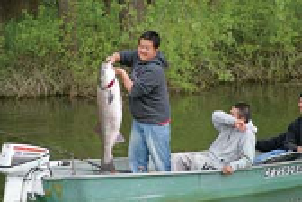Biology Reference
In-Depth Information
managed to evolve to survive a lot of the variability because they produce
a lot of eggs, can spawn multiple times, and are long-lived. So they can
out-survive short-term variations that might be deleterious to other fish
species,” he says.
White Sturgeon don't stray as far as Green Sturgeon do. A good number
will stay in and around the bay as long as there is something to eat. Adult
sturgeon feed on the bottom, snuffling along in the sediments for inverte-
brates. Some have been found with large quantities of the invasive Overbite
Clam in their bellies, not to mention lots of fish eggs. That sturgeon are
major egg predators is ironic, because humans prey on sturgeon to obtain
caviar. In California, strict fishing regulations have never completely de-
terred poachers. But UC Davis researchers have recently figured out how to
raise sturgeon in captivity to produce sustainable and legal California caviar.
Striped Bass
“Stripers,” as anglers call them, are not native to the bay's watershed. But
soon after they were imported from New Jersey in 1879, these anadro-
mous fish were spawning in the Sacramento River and the western delta,
producing hundreds of thousands of eggs and young, and sustaining a re-
gional commercial catch of over one million pounds of fish per year.
Mo-
rone saxatilis
is an unusually prolific fish: a nine-pound female can pro-
duce 900,000 eggs in one year; a 50-pounder, close to five million.
Not even the environmental degradation of the Gold Rush fazed the
Striped Bass: their semibuoyant eggs, long lives, and wide-ranging nature
helped them weather ups and downs in turbidity, salinity, and food supply.
In their new environment, Striped Bass soon became top predators, chas-
ing prey that had no evolutionary experience evading them, say scientists.
The bass did well in wet years and not so well in dry, like native species.
“An estuary that is good for Striped Bass by and large will also be good for
remaining native species that require a fully functioning estuary,” says UC
Davis fish biologist Peter Moyle.
As adults, these silver fish with dark stripes can live more than 20 years
and reach 50 to 100 pounds. No wonder these meaty prizes—whose high
Fishers both proud and nauseated by a
Striped Bass catch. (Francis Parchaso)


